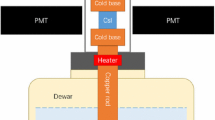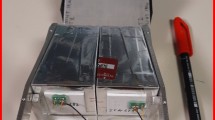Abstract
In this study, we constructed two annular detector arrays comprising 24 wedge-shaped CsI(Tl) crystals, and tested them using an \(\alpha\) source and radioactive beams of \(^{14-16}\)C on a CD\(_2\) target. We compared the properties of a CsI(Tl) crystal encapsulated with various reflectors, revealing that using the 80-\(\upmu\)m-thick ESR film to pack the CsI(Tl) crystal yielded the largest light output with the smallest non-uniformity in light output (\(\Delta\)LO). For the 24 CsI(Tl) detectors with the 80-\(\upmu\)m-thick ESR films, the average energy resolution improved as the average light output increased; however, it deteriorated as the \(\Delta\)LO value increased. To form two annular Si-CsI(Tl) telescopes for identifying the light-charged particles, the \(\Delta\)LO value and energy resolution of each CsI(Tl) detector were maintained under 20% and 7.7%, respectively. These telescopes were tested for the first time in a direct nuclear reaction experiment using \(^{14-16}\)C + d. The results demonstrated that the Z = 1 and Z = 2 charged particles were adequately discriminated by the telescopes using the standard \(\Delta E\)-E method.









Similar content being viewed by others
Data Availability
The data that support the findings of this study are openly available in Science Data Bank at https://www.doi.org/10.57760/sciencedb.j00186.00253 and https://cstr.cn/31253.11.
References
B. Davin, R.T. de Souza, R. Yanez et al., LASSA: a large area silicon strip array for isotopic identification of charged particles. Nucl. Instrum. Methods Phys. Res. A 473, 302 (2001). https://doi.org/10.1016/S0168-9002(01)00295-9
E. Pollacco, D. Beaumel, P. Roussel-Chomza et al., MUST2: A new generation array for direct reaction studies. Eur. Phys. J. A 25, 287 (2005). https://doi.org/10.1140/epjad/i2005-06-162-5
L. Acosta, E.V. Pagano, T. Minniti et al., FARCOS, a new array for femtoscopy and correlation spectroscopy. EPJ Web. Conf. 31, 00035 (2012). https://doi.org/10.1051/epjconf/20123100035
L. Acosta, R. Andolina, L. Auditore et al., Campaign of measurements to probe the good performance of the new array FARCOS for spectroscopy and correlations. J. Phys. Conf. Ser. 730, 012001 (2016). https://doi.org/10.1088/1742-6596/730/1/012001
M.S. Wallace, M.A. Famiano, M.-J. van Goethem et al., The high resolution array (HiRA) for rare isotope beam experiments. Nucl. Instrum. Methods Phys. Res. A 583, 302 (2007). https://doi.org/10.1016/j.nima.2007.08.248
D. Dell’Aquila, I. Lombardo, G. Verde et al., OSCAR: A new modular device for the identification and correlation of low energy particles. Nucl. Instrum. Methods Phys. Res. A 877, 227–237 (2018). https://doi.org/10.1016/j.nima.2017.09.046
D. Dell’Aquila, S. Sweany, K.W. Brown et al., Non-linearity effects on the light-output calibration of light charged particles in CsI(Tl) scintillator crystals. Nucl. Instr. Meth. A 929, 162–172 (2019). https://doi.org/10.1016/j.nima.2019.03.065
W. Liu, J.L. Lou, Y.L. Ye et al., Experimental study of intruder components in light neutron-rich nuclei via a single nucleon transfer reaction. Nucl. Sci. Tech. 31, 20 (2020). https://doi.org/10.1007/s41365-020-0731-y
G. Li, Z.W. Tan, J.L. Lou et al., Study on exotic structure of light neutron-rich nuclei via direct reaction. Nucl. Phys. Rev. 37, 426–437 (2020). https://doi.org/10.11804/NuclPhysRev.37.2019CNPC09. (in Chinese)
J.L. Lou, Y.L. Ye, Z.H. Yang et al., Progress of exotic structure studies in light neutron-rich nuclei. Chin. Sci. Bull. 68, 1004–1015 (2023). https://doi.org/10.1360/TB-2022-0942
J. Chen, J.L. Lou, Y.L. Ye et al., Low-lying states in 12Be using one-neutron transfer reaction. Phys. Rev. C 98, 014616 (2018). https://doi.org/10.1103/PhysRevC.98.014616
J. Chen, J.L. Lou, Y.L. Ye et al., A new measurement of the intruder configuration in 12Be. Phys. Lett. B 781, 412–416 (2018). https://doi.org/10.1016/j.physletb.2018.04.016
J. Chen, J.L. Lou, Y.L. Ye et al., Observation of the near-threshold intruder 0- resonance in 12Be. Phys. Rev. C 103, L031302 (2021). https://doi.org/10.1103/PhysRevC.103.L031302
Y. Liu, Y.L. Ye, J.L. Lou et al., Positive-parity linear-chain molecular band in 16C. Phys. Rev. Lett. 124, 192501 (2020). https://doi.org/10.1103/PhysRevLett.124.192501
Y. Jiang, J.L. Lou, Y.L. Ye et al., Quadrupole deformation of 16C studied by proton and deuteron inelastic scattering. Phys. Rev. C 101, 024601 (2020). https://doi.org/10.1103/PhysRevC.101.024601
G. Li, J.L. Lou, Y.L. Ye et al., Property investigation of the wedge-shaped CsI(Tl) crystals for a charged-particle telescopes. Nucl. Instr. Meth. A 1013, 165637 (2021). https://doi.org/10.1016/j.nima.2021.165637
W. Liu, J.L. Lou, Y.L. Ye et al., s- and d-wave intruder strengths in 13Bg.s. via the 1H(13B, d)12B reaction. Phys. Rev. C 104, 064605 (2021). https://doi.org/10.1103/PhysRevC.104.064605
W. Liu, J.L. Lou, Y.L. Ye et al., New investigation of low-lying states in 12Be via a 2H(13B, 3He) reaction. Phys. Rev. C 105, 034613 (2022). https://doi.org/10.1103/PhysRevC.105.034613
Z.W. Tan, J.L. Lou, Y.L. Ye et al., Investigation of negative-parity states in 16C via deuteron inelastic scatter. Chin. Phys. C 46, 054001 (2022). https://doi.org/10.1088/1674-1137/ac488b
J.X. Han, Y. Liu, Y.L. Ye et al., Observation of the \(\Pi ^2\sigma ^2\)-bond linear-chain molecular structure in 16C. Phys. Rev. C 105, 044302 (2022). https://doi.org/10.1103/PhysRevC.105.044302
Y. Sun, Z.Y. Sun, Y.H. Yu et al., Temperature dependence of CsI: Tl coupled to a PIN photodiode and silicon photomultiplier. Nucl. Sci. Tech. 30, 27 (2019). https://doi.org/10.1007/s41365-019-0551-0
Hamamatsu Photonics S3584-08, www.hamamatsu.com/jp/en/product/type/S3584-08/index.html
ORTEC 572A amplifier Manual. https://www.ortec-online.com.cn/products/electronics/amplifiers/572a
L.Y. Ma, H. Hua, F. Lu et al., A CsI(T1) detector array used in the experiment of Proton-rich nucleus 17Ne. Chin. Phys. C (SupplB) 33, 176–178 (2009). https://doi.org/10.1088/1674-1137/33/S1/056
Enhanced Specular Reflector Films, https://www.3m.com software
M. Janecek, W.W. Moses, Optical reflectance measurements for commonly used reflectors. IEEE Trans. Nucl. Sci. 55, 2432–2437 (2008). https://doi.org/10.1109/TNS.2008.2001408
M. Janecek, W.W. Moses, Simulating scintillator light collection using measured optical reflectance. IEEE Trans. Nucl. Sci. 57, 964–970 (2010). https://doi.org/10.1109/TNS.2010.2042731
J. Bea, A. Gadea, L.M. Garcia-Raffi et al., Simulation of light collection in scintillators with rough surfaces. Nucl. Instrum. Methods Phys. Res. A 350, 184–191 (1994). https://doi.org/10.1016/0168-9002(94)91162-2
A. Knyazev, J. Park, P. Golubev et al., Properties of the CsI (Tl) detector elements of the CALIFA detector. Nucl. Instrum. Methods Phys. Res. A 940, 393–404 (2019). https://doi.org/10.1016/j.nima.2019.06.045
E. Auffray, F. Cavallari, M. Lebeau et al., Crystal conditioning for high-energy physics detectors. Nucl. Instrum. Methods Phys. Res. A 486, 22–34 (2002). https://doi.org/10.1016/S0168-9002(02)00670-8
A. Knyazev, J. Park, P. Golubev et al., Tl concentration and its variation in a CsI(Tl) crystal for the CALIFA detector. Nucl. Instrum. Methods Phys. Res. A 975, 164197 (2020). https://doi.org/10.1016/j.nima.2020.164197
Q. Liu, Y.L. Ye, Z.H. Li et al., Investigation of the thickness non-uniformity of very thin silicon strip etectors. Nucl. Instrum. Methods Phys. Res. A 897, 100–105 (2018). https://doi.org/10.1016/j.nima.2018.100
R. Qiao, Y.L. Ye, J. Wang et al., A new uniform calibration method for double-sided silicon strip detectors. IEEE T. Nucl. Sci. 61, 596–601 (2014). https://doi.org/10.1109/TNS.2013.2295519
Author information
Authors and Affiliations
Contributions
All authors contributed to the study conception and design. Material preparation, data collection and analysis were performed by Hong-Yu Zhu, Jian-Ling Lou and Bo-Long Xia. The first draft of the manuscript was written by Jian-Ling Lou and all authors commented on previous versions of the manuscript. All authors read and approved the final manuscript.
Corresponding author
Ethics declarations
Conflict of interest
The authors declare that they have no competing interests.
Additional information
This work was supported by the National Natural Science Foundation of China (Nos.12275007, U1867214, 11775004), the funding from the State Key Laboratory of Nuclear Physics and Technology, Peking University, China (No. NPT2021ZZ01) and funding from heavy Ion Research Facility, Lanzhou, China (No. HIR2021PY002).
Rights and permissions
Springer Nature or its licensor (e.g. a society or other partner) holds exclusive rights to this article under a publishing agreement with the author(s) or other rightsholder(s); author self-archiving of the accepted manuscript version of this article is solely governed by the terms of such publishing agreement and applicable law.
About this article
Cite this article
Zhu, HY., Lou, JL., Ye, YL. et al. Two annular CsI(Tl) detector arrays for the charged particle telescopes. NUCL SCI TECH 34, 159 (2023). https://doi.org/10.1007/s41365-023-01319-8
Received:
Revised:
Accepted:
Published:
DOI: https://doi.org/10.1007/s41365-023-01319-8




